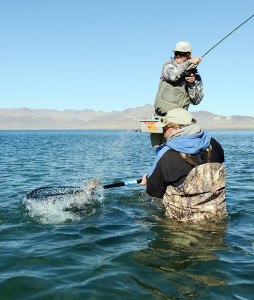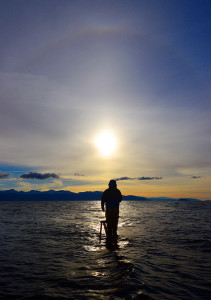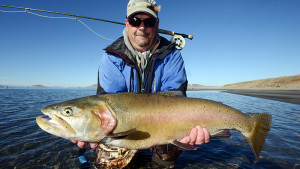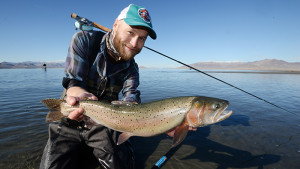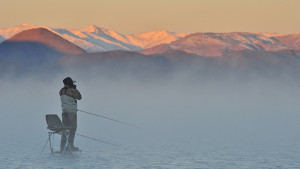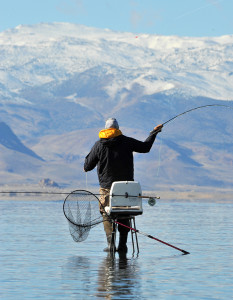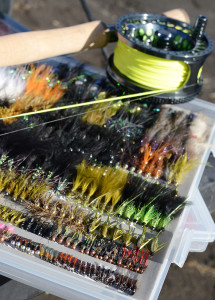Pyramid Lake, in the state of Nevada, is home to the world’s largest cutthroat trout. Below, Rasmus Ovesen takes you to the desert lake, which once was a vast inland ocean, and which offers a rather unique form of fly fishing where ladders are part of the basic outfit.
I’VE DONE MANY STUPID THINGS IN MY LIFE, and as a fly fisherman I’ve often stooped shockingly low – lower than I’d normally be willing to admit. Nonetheless, I never thought that my obsession with catching big trout on flies would one day see me towering idiotically from a stepladder in the middle of an American desert lake; thoughtlessly staring at an inanimate strike indicator the size of a small buoy. But here I am: in the bitter cold of winter, like an apathetic hunter in a hochsitz, with my fly rod in a flaccid grip and a crackling electrical feeling of shame trickling down my spine. This has nothing to do with fly fishing!
In order to prevent the feeling of stupidity from completely engulfing and overwhelming me, I give the bright orange Styrofoam ball out there a little tug, to make the nymphs below twitch a little – and to give the impression that I’m actually fishing (and not just sitting down looking down).
The worst thing is that I’m not alone with all these feelings. Several other fly fishermen have climbed atop stepladders along the lake’s dramatic depth curves. They speak gleefully to each other, laugh out loud, and whip their disproportionately big indicators out in front of their ladders with abrupt coarse fishing-like fly casts – without the slightest intimation of shame or ethical scruples.
They’re all doing it! But as I sit here, soaring above the water, I can’t help but feel a bit like a little silly. There are no mitigating circumstances, no cheap points to be scored on casting style or technique – and contrary to a lot of the other fishermen, I can’t seem to get a single bite. This is an all-time low in my fly fishing career, and the thought of having endured 36 hours of traveling to get here rips and tears inside me.
I’M AT PYRAMID LAKE in the western corner of the American state of Nevada. The lake is a remnant from a past long gone, a withering oasis in the middle of the desert surrounded by rusty-red plains and towering ridges clad in glittering newly fallen snow. Under the same monochrome sky and its bottomless pit of cobalt blue once lay a massive ocean – the Lahontan Sea.
Now there’s nothing left but a modest lake of about 48 x 14 kilometres staged by intricate limestone formations, rocky shorelines and big sandy beaches. In the lake, the world’s largest cutthroat trout are swimming about, but I find it hard to concentrate!
MY INDICATOR is right in front of my glorified observation post, a few meters out, according to my guide, Chris Evison’s, strict orders. Chris is a very pleasant guy, who knows the lake like the back of his hand. He sits comfortably reclined on his stepladder, keeping a keen eye on his strike-indicator while self-indulgingly delivering a longer monologue about the fishing in Pyramid Lake: something to the effect that the season has really come to an end, that the weather and wind conditions aren’t very favourable, and that I should have been here three weeks ago – or, alternatively, that I should come back in March.
I’ve heard this kind of talk before, but before I manage to strike back with one of the many bad guide jokes that I have picked up during my dubious career as a trout bum, the impossible happens. Chris’s yellow bobber gets pulled under – as if by an invisible force, and suddenly his fly rod arcs and bends straight into the handle.
FIVE MINUTES LATER, after competently conducting the fight with a dangerously bent rod tip, a six-kilo cutthroat trout is thrashing about below Chris’s ladder, and I net the fish. Wow! So this is what they look like, these ancient trout: built like pit bulls with massive spotted tails, powerful olive-green and orange-red flanks, big transparent burgundy fins, and over-dimensioned heads with blushing gills, glaring eyes and toothy jaws.
We shoot a couple of pictures of the impressive creature before releasing it, and I then find my place up on the ladder again. I lax into the seat and place my indicator, leader and two flies out near the drop off with a dreamy roll cast. But nothing happens, and it doesn’t take long before the tingling euphoric feeling subsides and I’m overpowered by restlessness and impatience.
Apparently, it takes more than a six-kilo trout to nail me to a stepladder! And the rest of the trip, I’m stubbornly stripping streamers along the lake’s depth curves – like the weathered Scandinavian coastal angler I was born.
“1, 2, 3, 4, 5….. 26, 27, 28, 29, 30”; I count inside my head, once I have cast out the sinking line. It is now at a suitable depth, and I proceed to retrieve the flies along the bottom with quick double-strips. I’m waist deep right at the edge of a sandbar, where the bottom drops off to three or four meters, and I have already had a couple of decent followers.
I’m about to recast, when – suddenly – a ghostlike figure shoots forward in the water behind my Minkie Suspender fly and inhales it. A redeeming pull propagates through the fly line followed by series of convulsive carbon fibre shocks. I’m now connected with one of the lake’s fiery-tempered cutthroat trout – a fish that spirals towards deeper water with the thick fly line trailing behind it.
A series of surges and a lot of hectic rolling on the surface later, I net a stunningly beautiful cutthroat trout of about 3 kilos – a fish that signals the beginning of some incredible fishing.
DURING THE LAST TWO DAYS where I’m wading and casting on my own, I catch several hard-fighting fish along the lake’s sandy drop offs. They all range from 50 to 60 centimetres – meaning they’d be considered trophy fish anywhere else in the world – and they’re supplemented by catches of a few cui ui, which is a peculiar looking but remarkably powerful bonefish-like species that only lives in Pyramid Lake.
During the course of the last couple of days I also witness the catch of an additional three big cutthroat trout – including an impressive 8-kilo warrior caught by a rather shocked young man from California. Unfortunately, I never get to experience a doomsday-strike from one of the lake’s mastodons. But that just means I won’t have to look for a stupid excuse to go back…
Fact file – Pyramid Lake
Pyramid Lake embodies the remains of the Lahontan Sea, which for thousands of years made up a massive water reserve in the western part of Nevada’s desert, covering an area of about 22.000km2.
Because of intense evaporation caused by climate change in the late Pleistocene era, water levels started declining, and today only three substantial water reserves remain – and Pyramid Lake remains the biggest with a surface area of about 490km2 and depths of more than 100 meters.
Pyramid Lake is fed by the Truckee River and there is no drainage. Even so, the water levels continue to drop due to evaporation, and in the process minerals accumulate in the lake’s water. As a result, Pyramid Lake is rather alkaline and the salinity is about 6 per mille (Approximately one sixth of sea water).
Pyramid Lake has earned its name because there are many pyramid-like limestone-formations in and around the lake –especially along the eastern shorelines. They have been formed by subaqueous springs through a process of mineral depositing, and they have since been exposed due to evaporation.
Besides cutthroat trout, Pyramid Lake is home to carp, Sacramento perch, tui chub and the very special cui ui (Chasmistes cujus), which is found nowhere else in the world.
Pyramid Lake is situated inside the Paiute indian reservation, an hour’s drive from the city of Reno, and fishing licenses can be bought via the following link: www.pyramidlake.us/pyramid-lake-permits.html
The fishing season starts on October 1st and lasts until June 30th, with the first three weeks of October and March being considered the peak seasons.
Fact file – Lahontan Cutthroat Trout
Pyramid Lake is home to the world’s largest cutthroat trout: the unique Lahontan cutthroat trout, which historically exceeded 25 kilos in weight. The fact that they’re still present in Pyramid Lake is rather miraculous, however, and it deserves a little background information.
In 1903 the Derby Dam was built in order to divert water from the Pyramid Lake drainage, The Truckee Lake, to farming land in Fallon. This not only lowered the water levels in the lake dramatically, it also blocked access to the upper parts of the Truckee River where the Lahontan cutthroat trout had spawned through decades. In 1939 the Pyramid Lake cutthroat trout was declared extinct, and they were replaced by cutthroat trout from Summit Lake in the north-western corner of Nevada. These fish quickly settled in the lake, but being differently genetically coded, these fish never reached sizes comparable to that of the original Lahontan strain.
Then in 1979 – more than 75 years after the species was declared extinct –biologist Dr Robert Behnke, from Colorado State University, stumbled upon a small population of Lahontan cutthroat trout in a tiny creek near Pilot Peek on the Utah border. What he found was an incredibly vulnerable population of trout that had been planted by a local farmer at the end of the 19th century – a trout population that wasn’t DNA-verified as genetically pure descendants of the Pyramid Lake Lahontan cutthroat trout until some 25 years later.
In 1995 biologists freighted fertilised Lahontan cutthroat trout eggs from the Pilot Peek creek to a hatchery in Gardnerville, and it was at the very last minute. A few years later, massive forest fires in the Pilot Creek area killed every living thing in the creek.
After many years of dedicated hatchery work, the first genetically pure Lahontan cutthroat trout were ready to be reintroduced into Pyramid Lake, and the rest – as they say – is history. The fish have settled in, they grow rapidly, and nowadays fish weighing more than 10 kilos are caught on a regular basis. If the fishery is managed well and the developmental and conservational efforts continue, it isn’t unrealistic that fish pushing 20 kilos will be caught once again in the lake.
Fact file – Fly Fishing Pyramid Lake
When fishing Pyramid Lake you’ll typically be using conventional 6 – 9 weight single-handed rods in combination with strike indicator nymph or streamer techniques.
For indicator fishing you’ll need a 9’6” or 10” rod, a WF-floating line and a four meter long tapered leader ending in a 10-12lb fluorocarbon tippet. 2.5 – 3 meters below the indicator you attach a weighted nymph or buzzer and an additional half a meter below you tie on a so-called Balanced Leech. The flies are then fished along the lake’s depth curves – typically at 3 – 4 meters of depth, and they are fished rather statically with just a few tugs and strips here and there.
For streamer fishing 9 – 9’6”7 – 9 weight fly rods in combination with 300 – 350 grain sinking lines, like – for instance – Scientific Angler’s Streamer Express, are used. At the end of the fly line a 5’5” leader with a 15lb tippet is attached. At the end of this leader, a streamer is tied on – for instance a tui chub imitation or a Clouser Minnow, and the leader is then prolonged with an additional meter of 12lb tippet material. This is done using a blood knot, which leaves the Clouser Minnow dangling from an“excess trim” of about 10 – 15 centimetres. At the very end of the tippet a foam fly with good buoyancy qualities – such as the Pyramid Beetle or a Tadpole fly – is then attached.
When streamer fishing at Pyramid Lake it’s important to know the sink rate of the fly line. It should be “counted down” to ensure that the flies are fishing at the right depth – right along the sandy bottom. The whole point is to make the dropper-fly drag or bounce on the bottom while the buoyant point fly hovers and lifts itself above the bottom.
The retrieve is very important. A lot of the locals swear by really abrupt and aggressive strips that provoke the fish into striking. Double-handed retrieves work really well when the fish are just following the fly – and they do that a lot in Pyramid Lake. For the same reason, it is important not to recast too soon, and to always finish each full retrieve with a short break before the fly is recast. Oftentimes, the fish will hit the fly right at your feet!
The flies that are used most frequently at Pyramid Lake, include: Pyramid Lake Beetles, Popcorn Flies, Tadpoles, emergers, buzzers, Wolly Buggers, Clouser Minnows, Mahalo Nymphs, Booby Flies, Silver Bead Eyes and – not least – Balanced Leeches.
A guide can be an important helping hand on this massive and unsettled lake, and in this regard Pyramid Lake Fly Fishing’s guide service is highly recommended:
www.pyramidlakeflyfishing.com
Fact file–Transport, logistics, and lodging
If you’re planning a trip to Pyramid Lake, you can book a plane ticket and fly to Reno (via San Francisco). From Reno, there’s only an hour’s drive to the lake. Lodging possibilities are limited out by the lake, so consider a hotel in Reno – the ”Biggest Little City in the World”. The grand, but very affordable, Nugget Casino and Resort, is worth staying at if you’re looking for an authentic Reno hotel experience: www.nuggetcasinoresort.com
Words + Photos by: Rasmus Oversen

